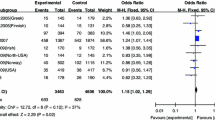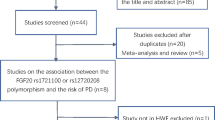Abstract
Fibroblast growth factor 20 (FGF20) is a neurotrophic factor which enhances the survival of rat midbrain dopamine neurons. Genetic variation in FGF20 may influence the risk of occurrence and development in Parkinson’s diseases (PD). Many studies have evaluated the association between FGF20 rs1721100 C/G polymorphism and the risk of sporadic PD; however, published data are still controversial. The aim of the present meta-analysis was to evaluate the association of FGF20 rs1721100 C/G polymorphism with susceptibility of PD. The summary odds ratio (OR) with its 95 % confidence interval (CI) was calculated to estimate the association. Five case–control studies with a total of 3,463 sporadic PD cases and 4,606 controls were finally included into this meta-analysis. Neither the basic allele frequencies nor the genotypic distributions of rs1721100 C/G within FGF20 were different between two groups when all studies were pooled into the meta-analysis. Subgroup analysis by ethnicity showed FGF20 rs1721100 C/G polymorphism was significantly associated with increased risk in the heterozygote comparison model (CG versus GG: OR = 0.83, 95 % CI, 0.72–0.95, P = 0.009) in Asians but not in Caucasians. Overall, this meta-analysis suggests that FGF20 rs1721100 C/G polymorphism is associated with sporadic PD in Asians.


Similar content being viewed by others
References
Shadrina MI, Slominskii PA (2008) Mitochondrial dysfunction and oxidative damages in the molecular pathology of Parkinson’s disease. Mol Biol (Mosk) 42(5):809–819
Ved R, Saha S, Westlund B, Perier C, Burnam L, Sluder A, Hoener M, Rodrigues CM, Alfonso A, Steer C, Liu L, Przedborski S, Wolozin B (2005) Similar patterns of mitochondrial vulnerability and rescue induced by genetic modification of alpha-synuclein, parkin, and DJ-1 in Caenorhabditis elegans. J Biol Chem 280(52):42655–42668. doi:10.1074/jbc.M505910200
Scott WK, Nance MA, Watts RL, Hubble JP, Koller WC, Lyons K, Pahwa R, Stern MB, Colcher A, Hiner BC, Jankovic J, Ondo WG, Allen FH Jr, Goetz CG, Small GW, Masterman D, Mastaglia F, Laing NG, Stajich JM, Slotterbeck B, Booze MW, Ribble RC, Rampersaud E, West SG, Gibson RA, Middleton LT, Roses AD, Haines JL, Scott BL, Vance JM, Pericak-Vance MA (2001) Complete genomic screen in Parkinson disease: evidence for multiple genes. JAMA 286(18):2239–2244 joc10904 [pii]
Hauser MA, Li YJ, Takeuchi S, Walters R, Noureddine M, Maready M, Darden T, Hulette C, Martin E, Hauser E, Xu H, Schmechel D, Stenger JE, Dietrich F, Vance J (2003) Genomic convergence: identifying candidate genes for Parkinson’s disease by combining serial analysis of gene expression and genetic linkage. Hum Mol Genet 12(6):671–677
Ohmachi S, Watanabe Y, Mikami T, Kusu N, Ibi T, Akaike A, Itoh N (2000) FGF-20, a novel neurotrophic factor, preferentially expressed in the substantia nigra pars compacta of rat brain. Biochem Biophys Res Commun 277(2):355–360. doi:10.1006/bbrc.2000.3675
Murase S, McKay RD (2006) A specific survival response in dopamine neurons at most risk in Parkinson’s disease. J Neurosci 26(38):9750–9760. doi:10.1523/JNEUROSCI.2745-06.2006
Ohmachi S, Mikami T, Konishi M, Miyake A, Itoh N (2003) Preferential neurotrophic activity of fibroblast growth factor-20 for dopaminergic neurons through fibroblast growth factor receptor-1c. J Neurosci Res 72(4):436–443. doi:10.1002/jnr.10592
van der Walt JM, Noureddine MA, Kittappa R, Hauser MA, Scott WK, McKay R, Zhang F, Stajich JM, Fujiwara K, Scott BL, Pericak-Vance MA, Vance JM, Martin ER (2004) Fibroblast growth factor 20 polymorphisms and haplotypes strongly influence risk of Parkinson disease. Am J Hum Genet 74(6):1121–1127. doi:10.1086/421052
Pan J, Li H, Wang Y, Ma JF, Zhang J, Wang G, Liu J, Wang XJ, Xiao Q, Chen SD (2012) Fibroblast growth factor 20 (FGF20) polymorphism is a risk factor for Parkinson’s disease in Chinese population. Parkinsonism Relat Disord 18(5):629–631. doi:10.1016/j.parkreldis.2012.01.017
Mizuta I, Tsunoda T, Satake W, Nakabayashi Y, Watanabe M, Takeda A, Hasegawa K, Nakashima K, Yamamoto M, Hattori N, Murata M, Toda T (2008) Calbindin 1, fibroblast growth factor 20, and alpha-synuclein in sporadic Parkinson’s disease. Hum Genet 124(1):89–94. doi:10.1007/s00439-008-0525-5
Satake W, Mizuta I, Suzuki S, Nakabayashi Y, Ito C, Watanabe M, Takeda A, Hasegawa K, Sakoda S, Yamamoto M, Hattori N, Murata M, Toda T (2007) Fibroblast growth factor 20 gene and Parkinson’s disease in the Japanese population. NeuroReport 18(9):937–940. doi:10.1097/WNR.0b013e328133265b
Clarimon J, Xiromerisiou G, Eerola J, Gourbali V, Hellstrom O, Dardiotis E, Peuralinna T, Papadimitriou A, Hadjigeorgiou GM, Tienari PJ, Singleton AB (2005) Lack of evidence for a genetic association between FGF20 and Parkinson’s disease in Finnish and Greek patients. BMC Neurol 5:11. doi:10.1186/1471-2377-5-11
Wider C, Dachsel JC, Soto AI, Heckman MG, Diehl NN, Yue M, Lincoln S, Aasly JO, Haugarvoll K, Trojanowski JQ, Papapetropoulos S, Mash D, Rajput A, Rajput AH, Gibson JM, Lynch T, Dickson DW, Uitti RJ, Wszolek ZK, Farrer MJ, Ross OA (2009) FGF20 and Parkinson’s disease: no evidence of association or pathogenicity via alpha-synuclein expression. Mov Disord 24(3):455–459. doi:10.1002/mds.22442
Xu X, Wang N, Xu H, Xie A, Jiang H, Xie J (2013) Fibroblast growth factor 20 polymorphism in sporadic Parkinson’s disease in Northern Han Chinese. J Clin Neurosci 20(11):1588–1590. doi:10.1016/j.jocn.2013.02.023
Ma CL, Su L, Xie JJ, Long JX, Wu P, Gu L (2014) The prevalence and incidence of Parkinson’s disease in China: a systematic review and meta-analysis. J Neural Transm 121(2):123–134. doi:10.1007/s00702-013-1092-z
Gao X, Scott WK, Wang G, Mayhew G, Li YJ, Vance JM, Martin ER (2008) Gene–gene interaction between FGF20 and MAOB in Parkinson disease. Ann Hum Genet 72(Pt 2):157–162. doi:10.1111/j.1469-1809.2007.00418.x
Acknowledgments
This work was supported by grants from the Excellent Young Scientist Research Fund (BS2011YY002) of Shandong Province and the Educational Department Fund (2011QZ005) of Shandong Province, China.
Author information
Authors and Affiliations
Corresponding author
Rights and permissions
About this article
Cite this article
Ma, ZG., Xu, J. & Liu, TW. Quantitative assessment of the association between fibroblast growth factor 20 rs1721100 C/G polymorphism and the risk of sporadic Parkinson’s diseases: a meta-analysis. Neurol Sci 36, 47–51 (2015). https://doi.org/10.1007/s10072-014-1884-4
Received:
Accepted:
Published:
Issue Date:
DOI: https://doi.org/10.1007/s10072-014-1884-4




